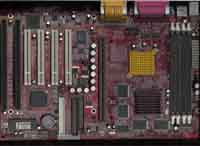A-Trend ATC-6254M BX Slot-1
by Anand Lal Shimpi on August 22, 1999 8:22 PM EST- Posted in
- Motherboards
The last time a motherboard by this manufacturer was reviewed on AnandTech was August '98, and the product was yet another Super7 motherboard for the increasingly popular K6-2 processor. While the board was a decent priced solution, it wasn't anything that really excited us when it arrived in our lab last year. This time around, A-Trend made a much bigger impact on us. The trend towards producing motherboard solutions with integrated video, sound and other such options has definitely picked up in pace since just a few years ago. Chipsets like the VIA MVP4 and the Intel 810 have raised the bar on quality for highly integrated motherboards, but the general consensus (at least from hardware enthusiasts like most of you) is that although the convenience of these motherboards is wonderful, the performance is horrid.
A-Trend set out to change that with their first performance gamer oriented motherboard, with integrated video and sound. What did they do on the ATC-6254M that is so radically different from what others have done in the past? Let's find out...
| CPU Interface | Slot-1 (SC242) |
| Chipset | Intel 440BX |
| L2 Cache | N/A (On-Chip) |
| Form Factor | ATX |
| Bus Speeds | 66 / 75 / 78 / 81 / 83 / 90 / 95 / 100 105 / 110 / 112 / 113 / 115 / 117 / 118 / 120 122 / 124 / 126 / 133 / 135 / 137 / 138 140 / 142 / 144 / 150 / 155MHz |
| Clock Multipliers | 1.5x - 8.0x |
| Voltages Supported | 2.0v / 2.8v (Auto-Detect) |
| Memory Slots | 4 168pin DIMM Slots |
| Expansion Slots | 0 AMR 0 AGP 4 PCI Slots (3 Full Length) 2 ISA Slots (0 Full Length) |
| BIOS | Award BIOS 4.51PG |
The Good
| The 6254M is obviously an attention grabber, the red PCB and colorful heatsink on the 443BX North Bridge are the first things that your eyes are drawn to. But you aren't looking at this board because of pretty colors, there are other motives in mind, primarily the contents beneath the second heatsink on the board, a considerably larger, black heatsink to be more specific. | |
| Now you've probably heard of integrated ATI Rage Pro controllers, integrated Rage 128 controllers, and even integrated i740 controllers, but have you ever seen a motherboard with an integrated Voodoo3? Beneath the hefty black heatsink is a 3dfx Voodoo3 2000, the same chip found on the $99 gaming card. The four chips that encircle it are 4MB Samsung 7-ns SDRAM modules that add up to the standard 16MB memory configuration supported by the Voodoo3. | |
The Voodoo3 2000 core on the board is clocked at the default 143MHz core with the 7ns memory clocked at 143MHz as well. For overclockers, the 7ns SEC SDRAM can be pushed up to the 166MHz clock the Voodoo3 3000 defaults it at, however if you remember the basic rules of the Voodoo3's architecture, the core and memory clock speeds always run at the same frequency. The next logical question is how far can the core be pushed? Luckily the core is the same 2000 featured on the retail boards, which generally hit the 166MHz level of the Voodoo3 3000, and as you can expect the 6254M exhibited a similar overclocking capability.
Since the 6254M was originally intended to be an OEM's board, the 2000 features no fan, however the beauty of the heatsink is that it is the perfect fit for an old 486 fan if you're looking to do a little extra cooling (or overclocking for that matter). A helpful addition to the 6254M is the thermal compound placed between the heatsink and the chip itself, something most retail graphics board manufacturers fail to include. The 6254M's design calls for an optional Voodoo 3000 part to be used, however with the aforementioned overclocking potential of the on-board 2000, a 3000 isn't really necessary. Because of the added features (TV/FM-input, etc...) it is highly unlikely that the 6254M or a variation of the board will ever be shipped with an on-board Voodoo3 3500, although it would be a nice setup.
The integrated sound on the 6254M is provided courtesy of the Yamaha 740 sound controller and in compliance with the PC'99 specification are the yellow audio I/O connectors that are an extension of the ATX backpanel.











0 Comments
View All Comments